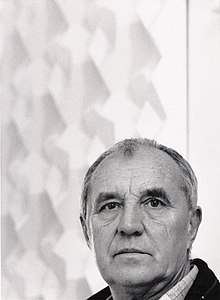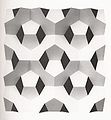Gerard Caris
Gerard Caris | |
|---|---|
 Gerard Caris | |
| Born | March 20, 1925 |
| Nationality | Dutch |
| Education | University of California, Berkeley |
| Known for | Visual artist |
Gerard Caris (born 20 March 1925) is a Dutch sculptor and artist who has pursued a single motif throughout the course of his artistic career, the pentagon.
Early life and education
He was born in Maastricht, the Netherlands. After attending the technical school in Maastricht he joined the marines as war volunteer trained in Camp Lejeune, N.C., United States, to end the occupation by Japan in World War II. During his training the war was ended by the atom bomb and he was sent to the late colony of the Netherlands Indonesia. In 1947 he came back to the Netherlands, only to leave soon afterwards to the far East in an attempt to escape the poverty of his native surroundings. Ten years later he decided to emigrate to the U.S. Here he studied art and philosophy at the New York University. Combining his art classes with earning a living and visiting all art happenings, museums and galleries, for example the Tinguely happening at the MOMA in NY in 1960 he was overwhelmed by Abstract expressionism and left for the Arabian desert in Dhofar, a sultanate of Muscat and Oman where he worked in his former trade as a petroleum engineer.[1] He did one more important job project, the erection of the Telstar Horn Antenna at the Andover earth station in Maine, then he traveled to California, inspired by the movie he watched while working in the Arabian desert Strangers When We Meet. He studied at the Monterey Peninsula College, California, the Monterey Institute of Foreign Studies and San José College (arts and humanities) subsequently at the University of California, Berkeley, a.o. with David Hockney, R.B. Kitaj, Elmer Bischoff and Richard Diebenkorn In 1967 B. A. in Philosophy, in 1969 M.A. in arts . He returned for a “short visit” to the Netherlands where he continued his art practice without realizing there is no intellectual resonance where he works but he is so possessed with his newly discovered Pentagonism that he does not realize he has landed on the moon. To this day he works continually, evolving new ideas, executes them, and making them public through exhibitions and publications, remaining optimistic, believing that ha has added a new chapter to the history of art self coined as Pentagonism.[2]
Gallery
-
Pentagon Complex 27 1995 Stedelijk Museum Amsterdam
-
Reliefstructure 2 C 3 1979 Stedelijk Museum Amsterdam
-
Studio 1983
Bibliography
- Gerard Caris SMA cahier 8 Stedelijk Museum Amsterdam 1997 ISBN 90-5006-124-9.
- Gerard Caris SMA cahier 23 Stedelijk Museum Amsterdam 2001 ISBN 90-5006-154-0
- Gerard Caris Pentagonismus/Pentagonism.Verlag der Buchhandlung Walther König, Köln, ZKM | Museum für neue Kunst Karlsruhe 2007 ISBN 978-3-86560-251-0
References
- ^ Catalog of an exhibition "Gerard Caris : pentagonisme = pentagonism" held at the Stedelijk Museum, Amsterdam Oct. 6-Nov. 25, 2001. Includes statement by the artist. "Stedelijk Museum, Amsterdam cat.no.860 [SMA Cahiers 23]" Evert van Uitert p.10-15
- ^ Gerard Caris : Pentagonismus = Pentagonism / herausgegeben von/edited by Gregor Jansen & Peter Weibel. Published : Köln : W. König ; Karlsruhe : Zentrum für Kunst und Medientechnnologie Karlsruhe, 2007. p 15-19



